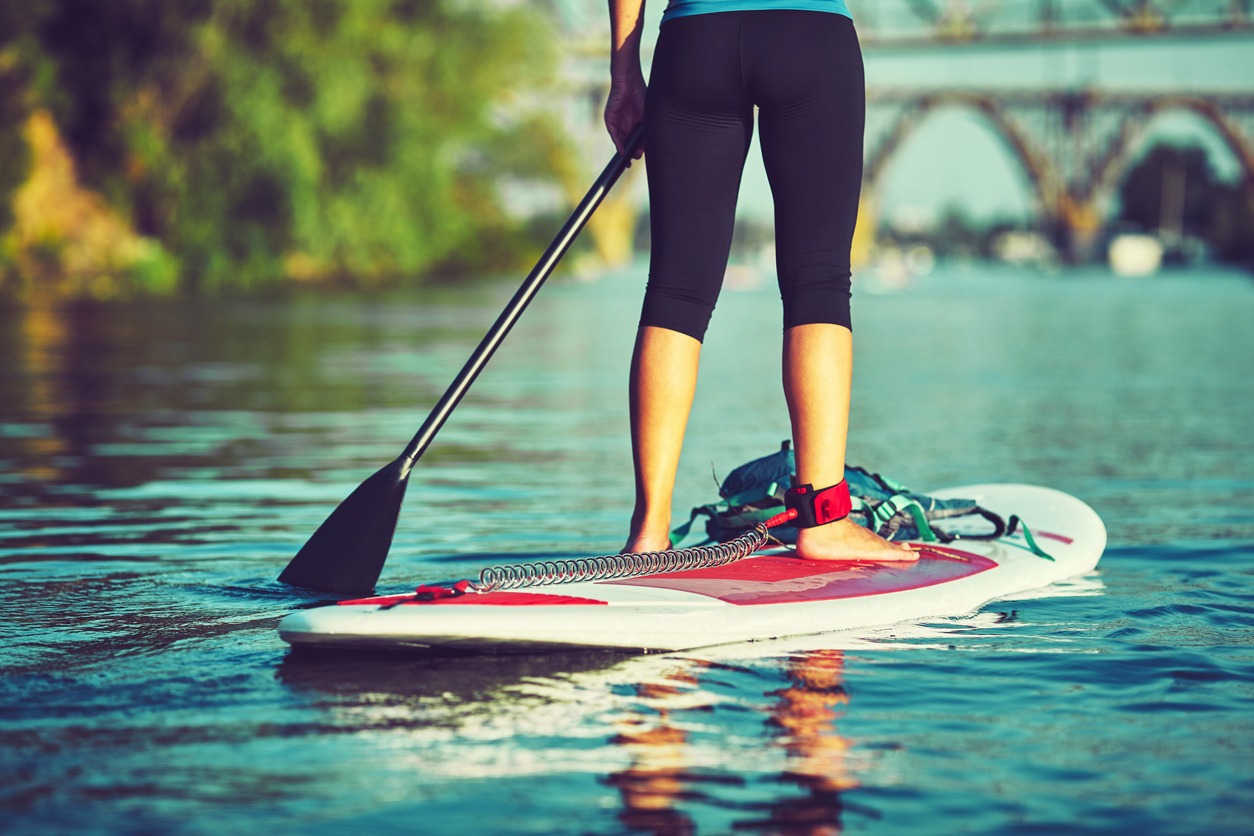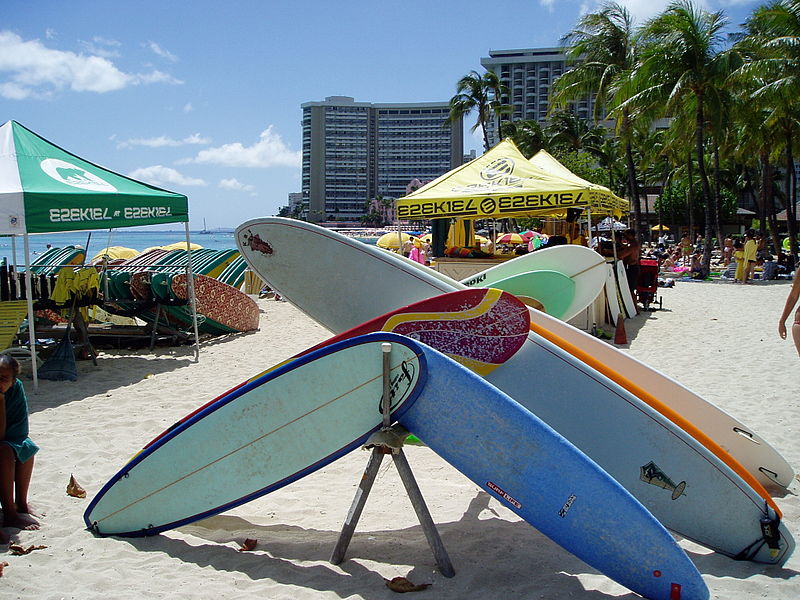Stand-up paddle boarding (SUP) is a water sport that involves standing on a board and using a long paddle to propel oneself through the water. The origins of stand-up paddle boarding can be traced back to ancient cultures such as the Polynesians, who used the technique to travel and fish. In more recent times, the sport has grown in popularity and has become a popular recreational activity.
Types Of Stand-Up Paddle Boards
All-Around Boards
All-around paddle boards are a great option for those who want a board that can handle a variety of activities and water conditions. They’re wider and more stable than specialized boards, making them a good choice for beginners or on calm waters. They’re also versatile enough to be used for activities like recreational paddling, yoga, fishing, and even light surfing.
They’re typically constructed with durable material and often feature tie-downs or bungee cords to secure gear while on the water. They are usually good for flat water, small waves, and sports touring.
Surf Boards
If you’re looking to catch some waves and perform some fancy maneuvers, then a surfboard is what you need. Unlike all-around boards, surfboards are specifically designed for riding waves, and as such, they tend to be shorter and wider. They usually measure between 8 and 10 feet in length, 30 inches wide, and 4 inches thick.
Surf boards have a wide tail, which makes them extra stable on the waves and perfect for making quick turns. So they are perfect for anyone who wants to have some fun and show off their skills on the water.
Racing
Racing stand-up paddle boards, or SUPs, is all about speed. They’re the longest and narrowest type of SUP and are built for competition and long-distance races. These boards are usually between 14 and 18 feet long, around 24 inches wide, and 4 inches thick. They have sharp noses and tails which help them slice through the water and a special hull shape that’s designed to displace water, which helps them go faster. In short, if you’re looking to compete or go on a long-distance paddle, a racing board is a great choice.
Yoga
Yoga stand-up paddle boards, or SUPs, are made for a different type of paddling experience. They’re built for stability and comfort, so you can do yoga on the water. These boards typically have a wide platform with a textured surface to provide traction, so you can safely perform different yoga poses on the board. They are perfect for anyone who wants to combine the benefits of yoga and paddleboarding and a great way to enjoy nature and yoga at the same time.
Inflatable vs. Solid Paddle Boards
Once you’ve decided on the type of stand-up paddleboard you want, whether it’s for surfing, yoga, racing, or something else, the next step is to decide between an inflatable and a solid board. Here’s a table of the main differences between the two types to help you make an informed decision:
| Inflatable Paddle Board | Solid Paddle Boards |
| Flexible and portable | Rigid and durable |
| Typically made of PVC (Polyvinyl Chloride) or similar materials | Typically made of foam or epoxy |
| Less stable in choppy water | More stable in choppy water |
| Easier to transport and store | More difficult to transport |
| Generally less expensive | Generally more expensive |
| Can be used for various water sports, such as touring and fishing | Can be used for various water sports, such as surfing and racing |
Hull types
A stand-up paddle board’s hull design plays a crucial role in its performance on the water. There are two main types of hulls:
Displacement Hulls
These hulls are pointed at the front and are designed to “cut” through the water. They’re typically found on touring and racing stand-up paddle boards and are great for longer trips and covering long distances.
Planing Hulls
These hulls are flatter and wider than displacement hulls and are designed to “ride” on top of the water. They’re typically found on all-around and recreational stand-up paddle boards and are great for general cruising and playing around in small waves.
Key Characteristics to Consider
Paddle boards come in a wide range of sizes and shapes, which can have a big impact on its performance and the type of activities it is best suited for. Following are the key characteristics to consider to make sure you are buying the right type for a particular activity.
Length
Board length is one of the most important factors to consider when choosing a paddle board. A longer board will typically be faster and more stable, but it will also be heavier and harder to maneuver. Shorter boards, on the other hand, will be more maneuverable but less stable and slower. Common lengths for stand-up paddle boards range from around 9-14 feet.
Width
The width of a paddle board is another important factor to consider. A wider board will be more stable, but it will also be heavier and harder to paddle. Narrower boards will be more maneuverable and easier to paddle, but they will also be less stable. Common widths for stand-up paddle boards range from around 25 to 35 inches.
Thickness
The thickness of a paddle board also play a role in its performance. Thicker boards will typically be more stable, but they will also be heavier. Thinner boards will be less stable, but they will also be lighter. Common thicknesses for stand-up paddle boards range from around 4-6 inches.
Volume
The volume of a board is a measure of its buoyancy and is determined by the length, width, and thickness of the board. A board with a higher volume will be more stable but also harder to paddle and slower, while a board with a lower volume will be less stable but also easier to paddle and faster.
Consider what activity you are planning to use the board for the most, whether it is surfing, racing, touring, or just all-around cruising. That will help you narrow down the size of the board you will need.
Accessories
Accessories are an important aspect of stand-up paddle boarding, as they can enhance your overall experience and make the sport more enjoyable. Some of the most popular accessories for stand-up paddle boards include:
Paddle
A high-quality paddle is essential for stand-up paddling, as it helps to propel you through the water. Look for a paddle that is lightweight, comfortable to hold, and adjustable in length.
Paddle Leash
A paddle leash is a safety feature that attaches your paddle to your wrist so that if you fall off your board, you will not lose your paddle.
Personal Flotation device (PFD)
A personal flotation device (PFD) is a safety item that can save your life in an emergency and is mandatory to carry on some waters. They also come in inflatable versions, which are more comfortable to wear. Make sure to check the local laws and regulations as these can vary from one state and country to another.
Dry bag
A dry bag can protect your gear, valuables, and food from getting wet. They come in different sizes and designs and can be useful when you’re paddling in choppy waters or during inclement weather.
Deck bag
Deck bags are attached to the deck of your board and can be used to store extra gear, such as sunscreen, snacks, or a camera.
Roof rack
If you plan on transporting your board to different locations, a roof rack is a great accessory to have. Roof racks come in different designs and can be used to securely transport your board on the roof of your car.
Ankle leash
An ankle leash is a safety item that attaches you to the board so that, in case you fall off, you will not be separated from it and can easily get back on track.
Repair kit
Paddle boards are durable, but they can still get damaged. A repair kit will allow you to make quick repairs in the field when something goes wrong.
Wetsuit/Drysuit
Depending on the climate and temperature where you will be paddling, you might need a wetsuit or drysuit for added warmth and protection from external elements.
FAQs
How do I transport my paddle board?
Paddle boards can be transported on the roof of a car using a specially designed roof rack. It’s also possible to transport them on the back of a truck or SUV. Inflatable paddle boards can be deflated and stored in a carrying bag, making them more portable and easier to transport in a car trunk.
Is stand-up paddle boarding difficult?
Stand-up paddleboarding can be challenging at first, especially if you’re not used to being on the water. But with practice, it becomes easier and can be a fun and exciting activity.
Conclusion
Buying a stand-up paddle board can be a great investment for those who love water sports and want to try a new form of exercise. There’s so much to consider when choosing a new stand-up paddleboard. Look out for those that meet your needs and fit your size. Also, make sure to protect your eyes while paddle boarding.

